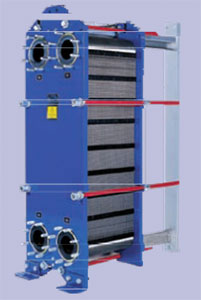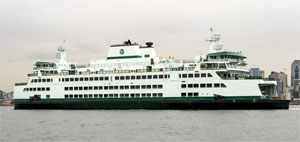Passengers on board the Washington State Ferries (WSF) boat Tokitae stay warm on a cold winter day as they travel on the Mukilteo-Clinton route, thanks to waste heat recovery installed on the two EMD diesel engines.
The system uses a water jacket heat exchanger from Alfa Laval to transfer heat from the cooling water jackets of the two 3,000-hp EMD 710 Tier 3-compliant engines to the accommodation heating system.
Since Tokitae entered service in June 2014, the ferry’s primary heating system has been powered by waste heat recovery, according to WSF vessels project manager Dave Visneski. Visneski said the weather since Tokitae’s commissioning has been handled totally by the waste heat system with the exception of the nightly tie-ups, when the main engines are not running.
“It is too early to tell, but preliminary indications are that we will save on fuel oil that would be required to run the diesel-fuel-fired hot water heater,” Visneski said. Tokitae is the first of two Olympic-class ferries to enter service.
Large military vessels and cruise ships have used such systems before. In the past few years, vessels ranging from the Maersk Triple-E class containerships, to a class of Crowley articulated tug-barges, to Canada’s Grand Manan Adventure ferry are capturing heat that would otherwise go unused and putting it to work on board.
The technology is advancing to make it more economical for smaller vessels to capture waste heat to generate electricity for boosting electric- drive propulsion and other uses, or to heat and cool accommodations for crew, passengers and cargo.
Waste heat recovery has been a staple in land-based applications such as power plants, cement factories and glass factories, anywhere high levels of heat are produced. It’s been adopted less rapidly in the marine industry.
“The amount of efficiency increase you can expect is reasonably modest, around 10 percent,” said Bruce Poole, a marine engineer and owner of Marine and Power Engineering in Morgan City, La. “For some people that’s a small number, but to me it’s a profound improvement.”
Some systems generate hot fluids or steam for heating and cooling systems, such as the lithium-bromide absorption chiller from Heinen & Hopman.
Arjen van Diermen, a project engineer at Houma, La.-based LeBlanc & Associates LLC, said his company’s projects usually involve using waste heat from hotel loads for heating and cooling. The company engineered the waste heat recovery system used for heating accommodations and the vehicle deck on Grand Manan Adventure, which operates in the Bay of Fundy.
Four years ago, Heinen & Hopman began reconfiguring a land-based absorption chiller for marine use, primarily for crew and passenger accommodations, taking into account the motion of the ship and beefing up the structure. The chiller can be operated on waste heat from the exhaust or water from the engine cooling system, van Diermen said, with backup power from generator power when the engine is not running.
“We take the cooling water from the engine that we used to throw overboard and now reuse it and don’t have to use the electricity from the generator to run the chiller,” van Diermen said.
The system is aimed at vessels with large enough engines to provide constant heat for the chiller, likely in the 300-foot range for containerships or large offshore supply vessels. The occupants of each stateroom can control the temperature according to their preferences.
According to the American Bureau of Shipping’s “Ship Energy Efficiency Measures Advisory,” modern diesel engines are very efficient with more than 50 percent of the energy generated from the combustion of fuel oil being converted to mechanical energy. They still produce a large amount of waste heat when running at full load. About 5 percent of the engine’s energy production goes to the engine cooling water system and about 25 percent is contained in the exhaust gas. Heat can be extracted from either system for use in other parts of the plant.
As ship and engine sizes have increased, the amount of exhaust heat available increases much more rapidly than the demand for steam for heating, according to ABS.
 |
|
An Alfa Laval heat exchanger unit that makes the process possible. |
|
Photo courtesy Washington State Ferries |
On the Maersk Triple-E class vessels, among the largest containerships in the world with two 43,000-hp diesel engines and a capacity of 18,000 TEU, a waste heat recovery system captures exhaust gas from the engine and directs it to turbine that produces mechanical energy to turn a generator. The goal is to trim fuel consumption and CO2 emissions by about 9 percent. Reports put the cost of installing a waste heat recovery system on each Triple-E vessel at about $10 million.
Figaro, a 747-foot car-truck carrier that handle up to 7,879 cars, is powered by a Doosan/MAN low-speed, 25,533-hp diesel. It has two types of waste heat recovery systems using Opcon’s Powerbox technology. The first system uses the organic Rankine cycle to generate up to 500 kW of electricity from heat recovered from the engine’s cooling water and other sources such as the purge air cooler.
The organic Rankine cycle uses an organic fluid that allows heat recovery from lower-temperature sources than plain water, which can more easily recover energy from low-grade waste heat sources to generate electricity.
The second system, the wet steam turbine, uses low-value heat from sources such as compartment heating without major modifications to use wet or saturated steam to drive a generator.
Overall, the operators expect a fuel savings of 4 percent to 6 percent, or about 200,000 to 250,000 tons of bunker fuel each year.
Savings can come when a waste heat recovery system replaces a diesel generator set.
“The typical fuel savings is about 12 percent with waste heat recovery, and since you’re not burning any more hydrocarbons you get a corresponding reduction in emissions,” said David Grucza, director of marine vertical for Siemens. “It also creates a little extra space on board the vessel because you have fewer diesels and because the diesels run less often, there’s lower maintenance as well.”
Waste heat recovery can work with all engine types, from heavy fuel oil to liquefied natural gas (LNG).
“For commercial viability where it pays for itself, you have to have in excess of 25 mW of diesel power on board the boat to get enough exhaust temperature to where the generator starts to make sense,” Grucza said.
Electricity can be generated in a variety of ways. GE Marine’s Clean Cycle system, developed by Echogen Power Systems, uses organic Rankine cycle technology to provide additional electric power by heating a supercritical carbon dioxide working fluid to drive a turbine coupled to an electrical generator.
A power management system routes the electricity to where it is needed regardless of where on the vessel it’s generated. The system can manage diesel generator sets for maximum fuel burn.
One of the obstacles for waste heat adoption is to devise a business case for generating electricity or steam on the vessel.
For instance, the Crowley articulated tug-barges Poole consulted on generated only about a half million BTUs from waste heat, although the engines have a capacity of several times that. But that’s all that was needed to generate enough steam to heat the heavy fuel oil for the engines.
“They could have done other things with the extra heat but that would have taken a more complex plant,” Poole said.
Vessels operating in northern climates are often better candidates for waste heat recovery projects because of the battle against the weather.
“It would be nice if some of those people going out with ball bats to break ice had pipes in the hulls, plumbing hot water or thermal oil through it to keep ice off instead,” Poole said.
Like any technology, it can take a while before it becomes mainstream. But ever-tightening emissions restrictions will be a big driver for wider adoption of waste heat technology.
“Some companies like Maersk see the value and benefits and drive the new technology, like any other industry where you have early adopters,” Grucza said.

